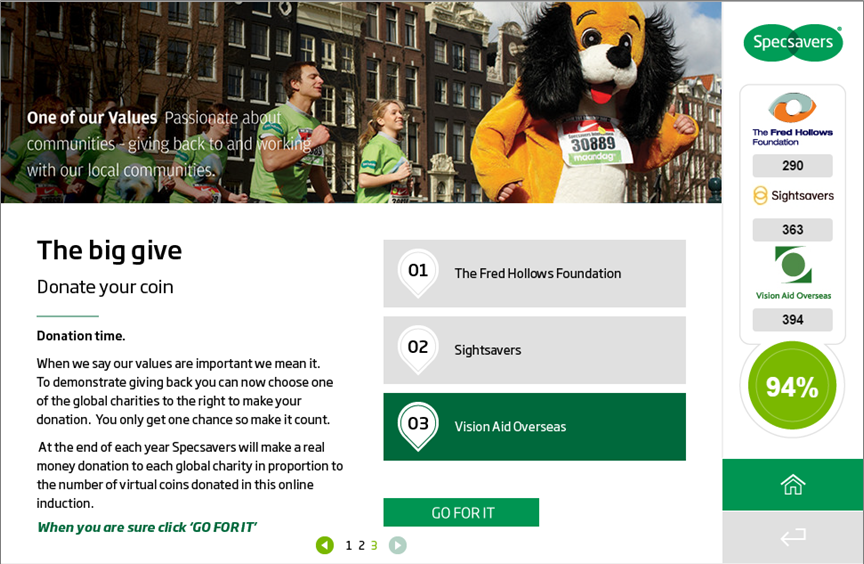Representing corporate culture in elearning induction

New employees need to be aware of the values at the heart of your business.
When your new starters are moving from candidate to employee, it’s your chance to make sure they are aware of the culture of your organisation and how they fit into it.
There’s no substitute for spending time in the company, but there are some shortcuts you can use to get everyone starting out on the same page.
What is corporate culture?
Erika Anderson defines corporate culture as:
“Patterns of accepted behaviour, and the beliefs and values that promote and reinforce them.”
An elearning course is a great way to introduce these ‘patterns of accepted behaviour’ to your new starters, efficiently and consistently. Most onboarding courses will include a guide to what is expected of employees, but the programmes that really stand out also reinforce the beliefs and values of the organisation.
A clear example is Disney, a company synonymous with its values.
If you want the ‘dos and don’ts’ of working at Walt Disney World Resort, there is a host of publicly available information on what to avoid, from visible undergarments to frowning. In addition, their YouTube channel has over 60 videos featuring employees and managers talking about their roles.
There’s no chance you’re going to be surprised by the culture when you turn up on Day One at Disney. The personal videos give you much more of an insight into the values of the individuals you’re going to work with, than a list of job requirements.
Companies without the same public profile as Disney can use similar techniques in their own digital onboarding course to prepare their new starters.
United Biscuits took a slightly different approach by using animated characters to tell the stories of real employees.

Their induction programme is available for new and existing staff and helps introduce a culture change. A new behavioural framework was being introduced across all parts of the business.
Using real situations from different areas of the business gives each new learner a look at who they would be working with. It also lets existing employees see real examples of how their colleagues are putting new behaviours into action.
Using video or animated content can bring the leading cultural figures of an organisation into the onboarding process cost effectively with minimal disruption to their schedule.
The Founder’s Voice
Using the point of view of real staff can reinforce the culture of your company. Often, the best embodiment of these values comes from the founder of the organisation.
The following three quotes about corporate culture are from the founders of Google, Amazon and Apple. Can you tell which is which?
- “Our culture is friendly and intense, but if push comes to shove we’ll settle for intense.”
- “Make sure everybody in the company has great opportunities, has a meaningful impact and is contributing to the good of society.”
- “Over a period of time, you realise that building a very strong company and a very strong foundation of talent and culture in a company is essential to making great products.”
Find the answers at the bottom of the post.
Facebook Engineering Bootcamp
Facebook is renowned for their Engineering Bootcamp. All members of the engineering department from entry-level coders to the Director of Engineering are required to attend.
Engineers at Facebook are not assigned a role or a team until after the intensive six-week onboarding process. At that point, they choose the team that is the best fit for them.
Bootcamp is all about the culture of the business and the employee’s role in that culture. They have already been accepted into the company, it’s time to find out where they fit.
Joel Seligstein, Bootcamp Engineering Manager
“We aim to help people ramp up as quickly as possible in a safe, supported environment while teaching our culture of how to move fast at our company.” –
What works well for Facebook might not be suitable for your business, but there are other ways to offer choice to your new starters that help them align with your values.
Sharing global values with a diverse workforce
In a business with more diverse roles, it’s not as easy to centralise the training of your beliefs and values. Specsavers faced the challenge of having different types of workers spread across the world.
By identifying the elements of culture that were common across the board, they were able to move a large part of their onboarding online and save time and expense of a longer face to face programme.
Simon Poole-Anderson explained in a live session during the Big Sponge Hangout:
“At Specsavers it feels like our values are something that we live and breathe – particularly corporate social responsibility is what we wanted to demonstrate to our new starters in a way in which they could feel like they’d had an impact before they’d even arrived on their first day.”
Once a learner has completed the pre-boarding course, they’re given the opportunity to choose a charity that Specsavers will make a real donation to on their behalf.

Giving new hires the ability to donate to charity reinforces the message that Specsavers’ values are important for every member of staff, wherever they work.
An elearning course is a really strong way to use technology to connect people across borders and roles before they arrive at their new job is only possible with an elearning course.
Practical tips
Working with a company to understand their culture is an important part of a learning designers process. I like to take these steps before designing an elearning course:
- External research – getting a really good understanding of the company culture starts with looking at the values shared publicly with customers and colleagues.
- Internal research – internal communications often have a different voice to the public facing content a company publishes. Reading up on reports and previous training materials gives a more balanced look at the values and beliefs of a company.
- Tone of voice – in interviews with stakeholders and subject matter experts run through exercises that reveal the internal tone of voice of a business.
- Talk to learners – have current employees give you an insight into how they see the company culture. Asking them to describe the company culture in a few words is a great starting point.
Having that deep understanding means when we write the elearning we can do so in a way which connects with the audience and reflects the company’s culture as part of their internal communications.
The techniques highlighted here give you a head start when creating digital onboarding programmes, but they’re only a part of the complete picture.
The important thing is to set out the underlying beliefs and values that have shaped your company and how these guide the things new starters will learn.
An elearning course can offer the best way to reach everyone who is starting their journey at your organisation.

Author: Rhea Stevens, Senior Learning Designer, Sponge
Quotes from founders: 1. Jeff Bezzos, Amazon, 2. Larry Page, Google, 3. Steve Jobs, Apple